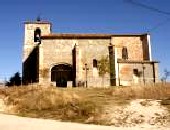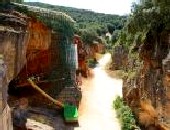Camino de Santiago - French Way - Stage 12, page 1 - San Juan de Ortega to Burgos
Total distance - 27.6 km
From San Juan de Ortega there are two routes to Burgos but the other, passing through the villages of Santovenia de Oca, Zalduendo, Ibeas de Juarros, Castrillo del Val, San Medel, Castañares, Villayuda, is hardly used therefore, described below is the standard route towards Burgos.
Upon leaving San Juan de Ortega you head past the church and walk down the Barrio de Colinas, takeing a right turn towards the way marked track through the pine woods. Not long out of the town you pass over a couple of cattle grids, through some open fields coming eventually to a large wooden cross. At this point keep well left, this path will take you through a small gate and down a dirt track towards the village of Agés.
There are 3 refugios/hostels in Agés. The Hostel San Rafael has a café and restaurant, and for those of you who wish it, internet access. One of the other hostels, Casa Caracol, which can be found on the Calle la Iglesia is supposedly to be one of the gems of the Camino.
Also in Agés you will find a sign which lets you know that you still have 518 kilometres to go before you reach Santiago.
The most dominant monument in the village is the 16th century Iglesia de Santa Eulalia. It is here that the remains of King Garcia de Navarre were originally entombed before eventually being moved to the Pantéon Real in the Iglesia María de Real in Nájera.
King Garcia had been the ruler of the kingdom of Navarre and his brother King Ferdinand I was ruler of the kingdom of Castilla y Leon. The kingdoms had at one time been part of the empire of King Sancho III of Navarre, their father, upon the king's death they were divided between the two brothers. Unfortunately, as has so often happened in history, one brother, King Garcia, being jealous of his sibling decided to go to war against his brother King Ferdinand. Unfortunately this resulted in his death in 1054 at the battle of Atapuerca.
To leave Agés walk down the main street past the fountain on the right and follow the street out of the village and down the road for approximately 2.5 kilometres until you reach the next village, Atapuerca.
On the road between Agés and Atapuerca you will come across a 2 metre high standing stone which marks the spot where the armies of King Garcia of Navarra and King Ferdinand of Castile met. The words inscribed on the stone are Fin de Rey – Garcia de Najera 1054. In English this translates to “end of the king – Garcia de Najera 1054.

Atapuerca is not a large village, having around 230 inhabitants, but it has an impressive church, la Iglesia de San Martín which overlooks the village from a small hill. Atapuerca was once known as one of the first villages to have been wrested back from the Moors (muslims) during the Reconquista. However, in the 20th century Atapuerca became world famous for the discovery of the most important archaeological site ever to be found, situated in the Sierra de Atapuerca hills some 3 kilometres from the village. The on-going archaeological dig was declared a world heritage site by UNESCO in 2000.
The site was originally discovered in the 1960's during the construction of a railway. However, since the 1980's the remains of more than 32 individuals have been found in La Sima de los Huesos, or the pit of bones. Most of the bones found here are over 300,000 years old.

In 1994, during excavations of an old railway cutting in Trinchera Dolina, close to Atapuerca, more bones were discovered. These were found to be over 800,000 years old thus making them the oldest Europeans and the discovery of the Atapuerca Man.
Most of the items found during the various digs are to be found either on display in the Museo de Burgos or in the Museo de Ibeas in the village of Ibeas de Juarros near Atapuerca. Visits to the site can also be arranged. A worthwhile website to look at before you go is www.atapuerca.net that has information in English. However the main information site is www.visitasatapuerca.com, which unfortunately is only in Spanish. This does contain information on visiting times and fees.
If you wish to stay in Atapuerca there are 2 Albergues and a hostel. There are also 2 bars, one with a restaurant, a café and bakery.
To leave Atapuerca walk through the village and just after the second bar and bakery take a left turn past the fountain and following a line of fencing on your left hand side up towards another cross. The path continues across open heathland and as the path begins to descend you will see the City of Burgos ahead.
Keep walking straight on passing some TV antennae and a quarry. Soon after passing the quarry the path starts to descend and you come to a fork in the road. At this point take the right hand fork and then turn right onto a minor road which leads you into the small hamlet of Villaval. This route is slightly longer but it takes you through some beautiful villages. The other route takes you mainly through stony pasture.
Pass through Villaval keeping to the road until after about 2 kilometres you come across the village of Cardeñuela Riopico. There is a small municipal Albergue here, the keys of which can be found either in the town hall or at the bar La Parada.
The road continues down towards Orbaneja Riopico where you meet up with the alternative route. About 1 kilometre away from the village you will come to a bridge over the A1 motorway. At this stage you are faced with 2 options for entering Burgos, both routes are clearly marked. The original or historic route takes you through Villafria an industrialised area which follows the very busy and noisy main road into Burgos. This is apparently the worst part of the whole Camino. The other, quieter route follows the river. It's slightly longer but is a much safer way to enter Burgos via Castañares, one of the suburbs.
We will detail both options below and it is then up to you which route you take. A third option is to take the Number 8 bus from Villafria into the centre of Burgos, but then that would be cheating.
Continued on Stage 12 - page 2.

